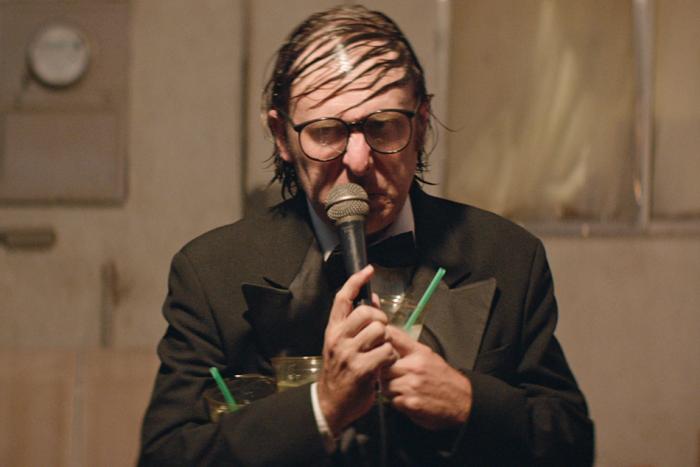"Imagine, if you will, the boulevard des Capucines, Paris, France, a December evening in 1895, the Grand Cafe, thirty or so Van Gogh chairs laid out in rows before a small white linen screen,” Gilbert Adair asks at the beginning of Flickers, a collection of one hundred essays about one film from each of cinema’s first hundred years. The screen was “far, far smaller than what we have become used to since, but that same screen, nevertheless, on which were to be imprinted the myths, dreams, drives, lies, desires, archetypes, whimsies, crochets, psychic megrims, and occasionally the history, of our century ... a screen on which materialized, that December evening, out of a flickering fog of capricious and irregular device, a skein of images—amazing moving images—of workers strolling out through the main gates of a Lyonnais photographic plant.” Workers Leaving the Lumiere Factory was screened with nine other films. It runs for forty-six seconds. The subject, the theatre, and the medium were all seemingly ephemeral, ghosts worn by a sheet.
Adair knew caprice. The late Scottish writer arranged Flickers to reflect his own memory and tastes; some of the judgments might annoy film scholars, especially that Adair “cannot quite regret” the destruction of King Vidor’s 1926 romance Bardelys the Magnificent. Displaying one of the surviving production stills, he explains:
“All that now remains of it is just this kind of posed snapshot, transfixing movement that can never again be cranked into life ... There's something strangely poignant about the whole notion of a 'lost' film, about the notion that a medium as slick and sleek and streamlined as the cinema turns out all along to have been as vulnerable as other, much older and more artisanal art forms. That a painting can be lost, yes, naturally, or an illuminated manuscript, or a score by Bach or Monteverdi, or even the choreography of a great 19th-century Russian ballet that no one knew properly how to transcribe. But a film? A movie, for God's sake? I find something perversely thrilling, something oddly ennobling, in such a loss.”
Most of the funerary canisters inside this crypt belong to silent films, seventy-five percent of which are now presumed lost. The very earliest ones were shown at dime museums, near the tattooed men or some minor villain’s pickled head, and then in nickelodeons, with their long rows of hand-cranked vignettes. Even as the movies grew less disreputable, little effort was made to preserve them, not when studios always needed extra vault space. And up until the early 1950s, film negatives and prints both used nitrate, a material so volatile that passing heat can spontaneously ignite it. (Only three theatres in the United States have a license to project nitrate.) Books may decay under the wrong conditions, but at least they won’t send flames licking over your hands. In that sense the idea of a “lost film” is almost too passive, a pre-industrial concept. Many were not stolen, misplaced, hidden, or forgotten. They fluttered into annihilation.
A drenched woodsman shows up, not too clear on how he arrived there, recalling his quest to save a woman named Margot from a gang. Or was she actually its leader? Now she’s a singer at a tropical nightclub, and we’re maybe 25 minutes into the movie, and still haven’t reached the sequence where Udo Kier requests a lobotomy to cure his all-consuming ass fixation.
Such cultural lacunae trip you up elsewhere as well. Ancient Greek theatre still exists onstage through the work of a handful of playwrights; only one of Sappho’s poems survives in its entirety. But no one expects antiquities to be whole. It’s the closeness of lost films to our own time that makes them so uncanny, that a Theda Bara could bewitch millions as eclipses do, leaving only scorch marks on the void. Looking at a photograph of the John Wilkes Booth conspirator Lewis Powell as he waited for the gallows, Roland Barthes wrote: “He is dead, and he is going to die … This will be and this has been.” The few remaining fragments from Cleopatra or London After Midnight have a similar effect on me, with the eerie possibility that one may yet shudder from its static past into the flow of the present. Ten years ago, a nearly complete print of Bardelys the Magnificent turned up in a French private collection. You can watch it on YouTube, which tends to dispel any necrotic mystique.
*
There’s another YouTube clip where Guy Maddin ransacks the Criterion Collection’s offices, grabbing DVDs off the shelf and declaring: “Bag!” I imagine that same thought process spawned his new film The Forbidden Room. It opens with a louche old man in a loose bathrobe, describing the history of washing: “The Japanese now have bisexual bathing … How do I know this? Someone told me, that’s how.” Maddin’s camera launches towards the bathwater and an imperiled submarine, as its crew tries to extend dwindling supplies of oxygen by chewing the air pockets caught inside their flapjacks. Then a drenched woodsman shows up, not too clear on how he arrived there, recalling his quest to save a woman named Margot from a gang known as the Red Wolves. Or was she actually its leader? Now she’s a singer at a tropical nightclub, and we’re maybe 25 minutes into the movie, and still haven’t quite reached the sequence where Udo Kier requests a lobotomy to cure his all-consuming ass fixation.
The Forbidden Room burst out from a number of overlapping Maddin creations, the earliest one being Hauntings, a 2010 installation at Toronto’s Lightbox. His goal was to essay 11 “unrealized, half-finished or abandoned films by otherwise successful directors,” a “ghostly collage.” The inspirations included Murnau, Lang, Mizoguchi, and Micheaux. I saw each short playing simultaneously, memory experienced as a series of distractions. Maddin has since reconceived that idea as an online project called Seances. The Forbidden Room was shot at the same time, but none of its many stories ostensibly came from existing non-existing films—except for that framing sequence “How to Take a Bath,” written by the poet John Ashbery, which borrows the flimsily educational premise of a 1930s sexploitation movie. “Work carefully in ever-widening circles,” the Maddin regular and Ashbery doppelganger Louis Negin suggests we soap.
Like someone dreaming of sex, The Forbidden Room can only reach its subject through swerving delirium. There are no comically precise fakes, a la Edgar Wright’s Don’t. The vignette about a Janus bust that drives its owner to murder sort of follows German Expressionist horror, and the vampire story is relatively straightforward until the creature turns into a bunch of bananas, but other segments—such as the one where Mathieu Amalric forgets his wife’s birthday and then attempts, with mounting chaos, to pass off all his own possessions as new gifts—resemble subgenres that never actually emerged. Maddin uses the language of early cinema while making up his own grammar. As in previous films such as My Winnipeg or The Heart of the World, he’s given The Forbidden Room feverish intertitles (“FORCED TO WEAR A LEOTARD!”) and handmade special effects, but the editing cuts between rapid, reeling close-ups. Each actor appears to be overplaying towards a different director.
Maddin has always been a pop Freudian, in the sense that pop is a heightened and more urgent form of everyday life. So those lumberjacks find themselves journeying inside “the pink warm centre of the cave,” somebody shoots their inner child, and the forbidden room itself finally reveals a literal “book of climaxes,” potential endings—zeppelin collision, a giant throbbing brain, the usual romance—that unfurl as apocalyptic ecstasy. He can get fetishistic about it; sometimes women are only seemingly onscreen for their severe flapper bobs. But Maddin does strive to be catholic in his perviness. Which other filmmakers have lingered so avidly on the bodies of elderly men? His kinks don’t include linear narrative, and the endless digression of The Forbidden Room suits Maddin’s exhausting pace better. I thought of the half-awake transitions throughout Crime Wave, fellow Winnipegger John Paizs’ 1985 debut feature—another lost film of sorts, since it was unavailable on any format for decades. Telescoping in and out of stories, the montage of a roiling subconscious.
At times the film nearly boils off the screen. Maddin’s co-director Evan Johnson dipped The Forbidden Room into an acid bath of post-production effects, disguising their computer file as fragile celluloid. The irony of the anachronism is that degrading tape drives and format obsolescence now threaten digitized films too: This has been and this will be. The Forbidden Room wears decayed, dissolving images like Death does his bones. Maddin and Johnson paint colours from a burning nitrate canister. Lava reds. Skies of violet. Jungle canopies seething the hue of radioactive waste. Families gather inside homes that might lie on the ocean floor, and sunlight falls tinted like margarine. Faces form from fire.
Lost films have their own un-canon, no more definitive than the others. The historian William K. Everson, who sawLondon After Midnight in the 1950s, considered it inferior to director Tod Browning’s own talkie remake Mark of the Vampire. The Forbidden Room imagines lost films not as artifacts to pine after but the accumulated muck of cinematic history, a place where mushrooms bloom phosphorescent. Maddin once defined melodrama as “the truth uninhibited,” emotions too wild to otherwise reveal. What if Theda Bara vamped through a weepy medical romance? Which tropes would an alternate universe recognize? So leave the factory gates. Take off your uniform. Draw a hot bath. Sink into the water. Let all that dirt float to the surface.






